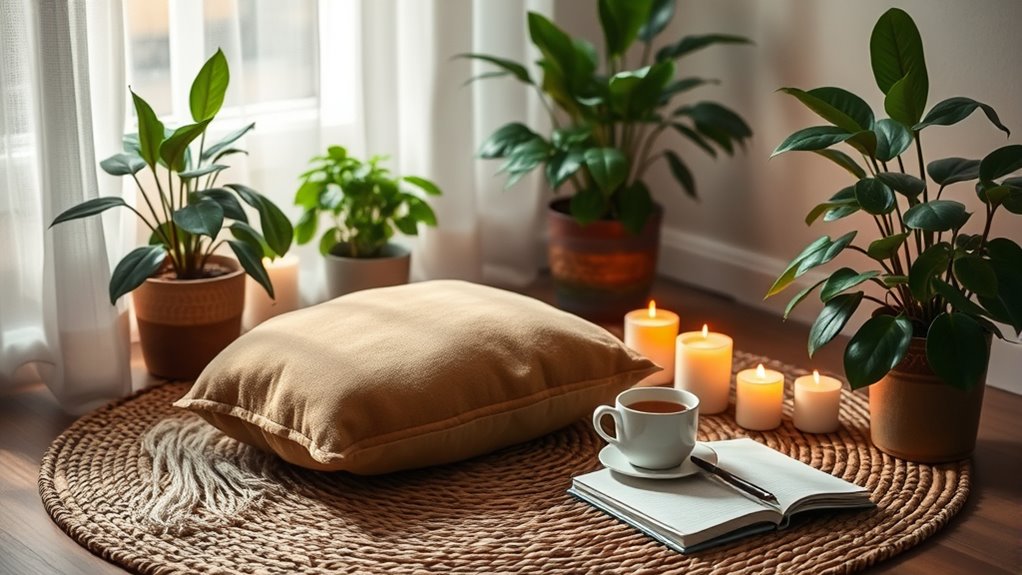The 4-Part SOS routine for mindfulness when feeling anxious involves quick, effective steps to regain control. Start with mindful breathing, taking slow, deep breaths to calm your nervous system. Then, do a body scan, focusing on sensations from your toes to your head to anchor yourself in the present. Incorporate grounding techniques if needed, like feeling your feet on the floor. These simple tools can help you manage anxiety instantly, and exploring each part further can deepen your calming skills.
Key Takeaways
- The 4-Part SOS Routine combines breathing exercises and body scans to quickly reduce anxiety.
- It helps anchor awareness in the present moment, breaking the cycle of anxious thoughts.
- Deep, slow breathing activates calming nervous system responses during stressful episodes.
- The body scan enhances bodily awareness and promotes relaxation by noticing sensations non-judgmentally.
- Regular practice of this routine builds resilience, making it easier to manage future anxiety triggers.

Have you ever wondered how staying present can help ease your anxiety? When anxiety hits, your mind tends to spiral with worries about the future or ruminate over past mistakes. Practicing mindfulness can anchor you in the moment, giving you a sense of control and calm. One effective way to do this is through simple techniques like breathing exercises and a body scan. These methods allow you to step out of anxious thoughts and reconnect with your body and breath, which are always present.
Breathing techniques are some of the easiest tools to use anytime you feel overwhelmed. When you notice your anxiety rising, take slow, deep breaths—inhale for a count of four, hold for a count of four, then exhale for four. Repeat this pattern a few times. Focusing on your breath shifts your attention away from racing thoughts and back to the present. It also activates your parasympathetic nervous system, which helps calm your body down. As you breathe intentionally, you become more aware of how your body responds to stress, fostering a sense of control and safety.
Deep, slow breathing activates your calming nervous system and helps you regain control.
A body scan is another powerful mindfulness practice that can help you ground yourself. To do this, find a quiet space, close your eyes if you’re comfortable, and bring your attention to different parts of your body, starting from your toes and moving upward. Notice any sensations—tightness, warmth, tingling, or even nothing at all. If your mind wanders, gently bring it back to the body part you were focusing on. This process helps you become more aware of physical tension or discomfort that often accompanies anxiety. By acknowledging these sensations without judgment, you prevent them from spiraling into more intense feelings. The body scan encourages you to stay present with what is, rather than fighting or avoiding it.
Both breathing techniques and the body scan are accessible, quick, and effective. They serve as a mental reset button, giving you a moment to pause and recenter whenever anxiety threatens to take over. Incorporating these practices into your daily routine or using them as immediate coping tools can markedly reduce the intensity of anxious episodes. With regular practice, you’ll find it easier to stay present, even amidst chaos. This shift not only eases your anxiety but also builds resilience, empowering you to face stressful situations with greater calm and clarity. Remember, the key is consistency, and practicing these techniques regularly enhances their effectiveness. Over time, these small acts of mindfulness become powerful anchors in your mental health toolkit.
Frequently Asked Questions
How Long Should I Practice the SOS Routine Daily?
For the SOS routine, there’s no strict duration guidance; start with 5 to 10 minutes daily. Consistency benefits your progress, so aim to practice at the same time each day. As you become more comfortable, you can extend your practice if desired. Remember, regular practice helps your mind adapt, reducing anxiety more effectively over time. Keep it simple and steady—your commitment makes a difference.
Can Mindfulness Completely Eliminate Anxiety Symptoms?
Imagine trying to duct tape a leaky faucet with a paper towel—sounds hopeful, but it’s not a fix. Mindfulness effectiveness varies; it can reduce anxiety, but it’s unlikely to completely eliminate symptoms. You might manage anxiety better, finding some relief, yet it’s not a magic cure. Embrace mindfulness as a helpful tool, not a total solution, and combine it with other strategies for more effective anxiety management.
Is the SOS Routine Suitable for Severe Anxiety Attacks?
You wonder if the SOS routine suits severe anxiety attacks. It can help, but isn’t a cure-all. The routine combines breathing techniques to calm your body and cognitive restructuring to challenge anxious thoughts. During intense attacks, these tools may provide quick relief, but if your symptoms are severe, it’s essential to seek professional help. The SOS routine is a valuable part of a broader anxiety management plan.
What if I Find It Hard to Focus During Mindfulness Exercises?
Did you know that nearly 60% of people struggle with focus challenges during mindfulness exercises? If you find it hard to focus, don’t worry—distraction techniques can help. Try gently redirect your attention without judgment when your mind wanders. Use deep breathing or focus on physical sensations to anchor yourself. These strategies help manage distraction, making it easier to stay present and reap the benefits of mindfulness, even with focus challenges.
Are There Any Contraindications for Practicing Mindfulness for Anxiety?
You might wonder if there are contraindications for practicing mindfulness for mental health. Generally, mindfulness is safe, but if you have severe mental health issues like trauma or psychosis, it could sometimes trigger distress or worsen symptoms. It’s best to consult a mental health professional beforehand, especially if you’re unsure. They can guide you on whether mindfulness suits your specific needs and help tailor your practice safely.
Conclusion
Practicing the 4-part SOS routine is like tending to a garden—you nurture your mind with mindfulness, watering it daily. Over time, anxiety’s weeds fade, making space for calm and clarity to grow. Remember, this routine is your toolkit for staying rooted amidst life’s storms. With patience and consistency, you’ll find your inner peace blossoming, turning stress into serenity. Keep tending your mental garden, and watch tranquility flourish.










